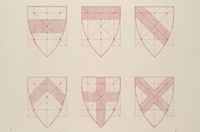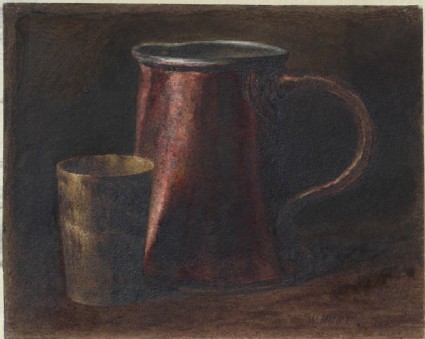Ruskin's revision to the Rudimentary series (1878)
Unpublished manuscript catalogue for proposed re-organisation of the Rudimentary series.

Ruskin's Catalogues: 1 object
Show search help- Reference URL
Actions
Study of a Copper Pot and a Horn Mug William Henry Hunt
-
Ruskin text
R|60} Study of copper pot and horn mug. W. Hunt. -
Details
- Artist/maker
-
William Henry Hunt (1790 - 1864)
- Object type
- drawing
- Material and technique
- watercolour and bodycolour on paper
- Dimensions
- 107 x 134 mm
- Inscription
- Recto, bottom right, in watercolour: W. HUNT 1825
Verso, bottom left, in graphite: R60
- Provenance
-
Presented by John Ruskin to the Ruskin Drawing School (University of Oxford), 1875; transferred from the Ruskin Drawing School to the Ashmolean Museum, c.1949.
- No. of items
- 1
- Accession no.
- WA.RS.RUD.060
-
Subject terms allocated by curators:
Subjects
-
References in which this object is cited include:
References
Ruskin, John, The Ruskin Art Collection at Oxford: Catalogue of the Rudimentary Series, in the Arrangement of 1873, ed. Robert Hewison (London: Lion and Unicorn Press, 1984), cat. Rudimentary no. 60, RUD.060
Ruskin, John, Instructions in Practice of Elementary Drawing, Arranged with Reference to the First Series of Examples in the Drawings Schools of the University of Oxford (n.p., [1872]), cat. Rudimentary no. 60
Ruskin, John, Instructions in the Preliminary Exercises Arranged for the Lower Drawing-School (London: Smith, Elder, 1872), cat. Rudimentary no. 60
Ruskin, John, Instructions in the Preliminary Exercise Arranged For the Lower Drawing-School (London: Spottiswoode, 1873), cat. Rudimentary no. 60
Ruskin, John, ‘Rudimentary Series 1878’, 1878, Oxford, Oxford University Archives, cat. Rudimentary no. 60
Witt, John, William Henry Hunt (1790-1864): Life and Work, with a Catalogue (London: Barrie and Jenkins, 1982), no. 685, pl. 52
Ruskin, John, ‘The Ruskin Art Collection at Oxford: Catalogues, Notes and Instructions’, Edward T. Cook and Alexander Wedderburn, eds, The Works of John Ruskin: Library Edition, 39 (London: George Allen, 1903-1912), 21, cat. Rudimentary no. 60
Location
-
- Western Art Print Room
Position in Ruskin’s Collection
Ruskin's Catalogues
-
Ruskin's Rudimentary series, 3rd ed. (1872)
R|60} Study of copper pot and horn mug. W. Hunt. -
Ruskin's Rudimentary series 4th ed. (1872)
R|60} Study of copper pot and horn mug. W. Hunt. -
Ruskin's Rudimentary series, 5th ed. (1873)
R|60} Study of copper pot and horn mug. W. Hunt. -
Ruskin's revision to the Rudimentary series (1878)
remains 60.Standard example of colour-execution on objects more or less rustic and picturesque, yet having great R. subtlety in some parts, as, for instance, here the edge of the horn-mug. There is scarcely any difference between this and the finest Venetian execution, except that the Venetian, being almost invariably of beautiful things, is itself always graceful and beautiful to the utmost degree. For instance, had the rim of the mug been of silver instead of pewter, Hunt’s execution would have become a little more delicate; but as in England our powers of enjoyment are more rustic than refined - so that we may any day produce a Bewick, a Gainsborough, or a William Hunt, but have little chance of producing a Filippo Lippi - the manner of execution in this drawing is that for the most part best adapted to the national temper which, if compelled to be refined, nearly always becomes mechanical.





